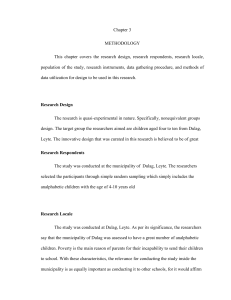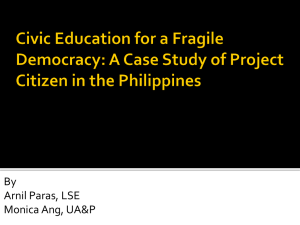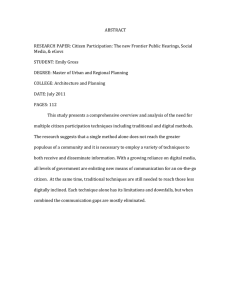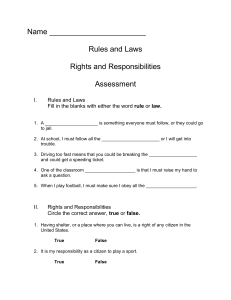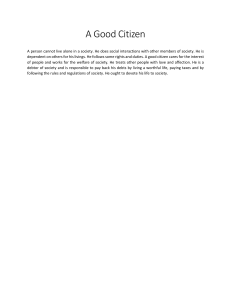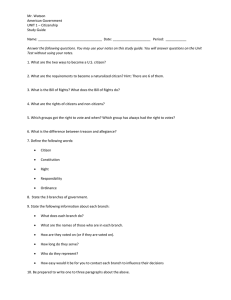Senior Citizen Information System Capstone Project
advertisement
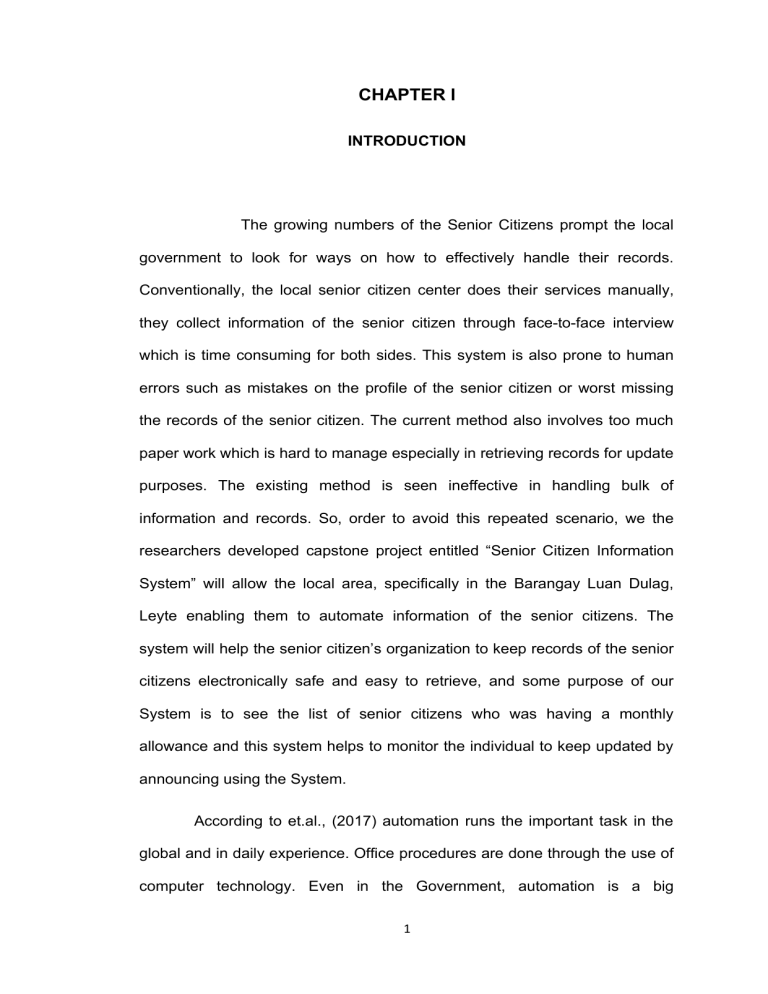
CHAPTER I INTRODUCTION The growing numbers of the Senior Citizens prompt the local government to look for ways on how to effectively handle their records. Conventionally, the local senior citizen center does their services manually, they collect information of the senior citizen through face-to-face interview which is time consuming for both sides. This system is also prone to human errors such as mistakes on the profile of the senior citizen or worst missing the records of the senior citizen. The current method also involves too much paper work which is hard to manage especially in retrieving records for update purposes. The existing method is seen ineffective in handling bulk of information and records. So, order to avoid this repeated scenario, we the researchers developed capstone project entitled “Senior Citizen Information System” will allow the local area, specifically in the Barangay Luan Dulag, Leyte enabling them to automate information of the senior citizens. The system will help the senior citizen’s organization to keep records of the senior citizens electronically safe and easy to retrieve, and some purpose of our System is to see the list of senior citizens who was having a monthly allowance and this system helps to monitor the individual to keep updated by announcing using the System. According to et.al., (2017) automation runs the important task in the global and in daily experience. Office procedures are done through the use of computer technology. Even in the Government, automation is a big 1 contribution to help and reduce task and give effect to society. The Senior Citizen Information Management System is a system that manages the registration to make work easier and less hustle for the golden age. People who are more than sixty years of age are commonly referred to as Senior Citizens or seniors. These terms refer to people whose stage in life is generally called old age, though there is no precise way to identify the final stage of a normal life span. People are said to be senior citizens when they reach the age of sixty or sixty-five because those are the ages at which most people retire from the workforce. The records of member of Senior Citizen had been curtail over time due to large numbers of citizen’s due to poor record keeping since it is a manual based method. In Barangay, Luan, Dulag, Leyte, manual method led to various problems and these include unnecessary duplication of recorded data, difficult in tracing previous members of record, eventually it is difficult to trace the flow of member past data. Objectives of the Study The Main goal of the project is to design and develop a system that will automate all process in managing information and records of Senior Citizens in Barangay Luan Dulag, Leyte. Specifically, project aims the following objectives: 1. To develop a system that assist the staff to electronically process the records of the senior citizens. 2. To develop a system that will eliminate the paper works handled by the staff in the senior citizens center. 3. The system is efficient, safe and reliable to use. 2 Scope and Delimitation of the Study This system will highly benefit them since they are in charge in managing and keeping the records of the Senior Citizens in their respective Barangay Luan, Dulag Leyte. Our system will assist the head of senior citizens organization or the president in carrying out their task without using the manual method which is prone to errors. Also, Senior citizen’s is highly benefit them in processing their records in the comfort of their homes especially to this pandemic or new normal that were facing right now. They would not need to personally visit the office to register their self as a senior citizen. This system will assure them that their records are accurate and safe. Significant of the Study The success of the project is deemed beneficial to the following: Senior Citizen Office - The success of the project will highly benefit them since they are in charge in managing and keeping the records of the senior citizens in the Respective of Barangay Luan Dulag, Leyte. The system will assist them in carrying out their task without using the manual method which is prone to errors. Senior Citizen - Given their age, the system will highly benefit them in processing their records in the comfort of their homes. They would not need to personally visit the office to register their self as a senior citizen. The system will assure them that their records are accurate and safe. 3 Researchers - The success of the project will contribute to their knowledge and skills as program developers. Chapter II THEORETICAL SYSTEM REVIEW OF RELATED LITERATURE Systems are used to enhance the user experience by providing tailormade services based on the user’s interests and preferences which are typically stored in user profiles. For such systems to remain effective, the profiles need to be able to adapt and reflect the users’ changing behavior. In this paper, we introduce a set of methods designed to capture and track user interests and maintain dynamic user profiles within a personalization system. User interests are represented as ontological concepts which are constructed by mapping web pages visited by a user to a reference ontology and are subsequently used to learn short-term and long-term interests. Educational Gerontology, v46 n2 p84-94 2020 Hedegaard, Joel; Hugo, Martin The increasing proportion of senior citizens in the population places new demands on the existing welfare system, in terms of the delivery of social services, but also with respect to democratic issues such as 'inclusion' and 'participation.' Participation in adult education offers a context where senior citizens can be included in society, experience meaningfulness, and even 4 create the conditions for their own well-being. In Sweden, there exist formal adult education systems that have enjoyed more success than others with respect to attracting groups of senior citizens who traditionally have not participated in the same degree in this domain. The Folk High School is one such educational system. The purpose of this article is to provide a description of how Folk High School senior courses are organized and what role the courses that are offered there play in the participants' lives with respect to meaningfulness, their well-being, and lifelong learning. Eight focus group interviews with 33 participants were conducted at eight different Folk High Schools in southern Sweden. The results of this study indicate that Folk High Schools' senior courses are organized together with the participants and in such a manner that interaction with participants from other courses is made possible. This interaction gives rise to an unpretentious- and, in a broad sense, an intercultural learning experience. The participants experience this as meaningful, and as something which impacts on their quality of life in a positive manner. Furthermore, it plays an important function in the participants' continued life-long learning. http://dx.doi.org/10.1080/03601277.2020.1712773 Georgia Educational Researcher, v17 n1 Article 2 p11-21 January, 2020 Senior citizens are becoming a larger and more significant part of the workforce as they desire to work longer. Companies have found these 5 individuals bring valuable skills to the workplace; however, they frequently need to update those skills or pursue new degrees. Since 1976, Georgia has had a law granting senior citizens tuition waivers in the state's public higher education institutions, thus allowing them the ability to take courses to update their skills. This study assessed the current status of the tuition waiver program by reviewing web sites of the 26 institutions in the University System of Georgia to determine how well the program is publicized. It also reviewed enrollment data to determine whether senior citizens are taking advantage of the benefit. The results reveal that web sites vary widely in publicizing the program, very few sites are easy to navigate, and a very small proportion of senior citizens are utilizing the tuition waiver. It is recommended that institutions improve their sites to enhance awareness and enrollment. Also, chambers of commerce, workforce development agencies, and senior citizen support agencies are encouraged to market the program more widely, thus providing benefits to the individuals, employers, and the economy. https://eric.ed.gov/?q=Senior+citizens+information+system+ +&pr=on&id=EJ1242351 MATEC Web of Conferences 342, 2021 Sorina Corman 6 The paper presents an inventory of standards, indicators, procedures and tools that ensure the assessment and monitoring of quality in elderlyoriented social services and proposes a synthetic analysis of the concept of “elderly people” as reflected in documents specific to the field of social assistance. Data analysis follows the classic stages of content analysis: inventory of standards, indicators, procedures and tools; standardization of the information contained in the aforementioned quality standards, classification into units of analysis, establishment of the main categories of analysis, coding and final analysis of the data. The information obtained was broken down into three categories: senior citizens in specific roles, the elderly in the relational system, this age group in the dynamics of integration. Each category resulting from the analysis provides a specific picture of the life dimensions of institutionalized seniors. The main conclusion is that the intervention of social workers in a quality management system can be correlated with these resulting dimensions, and one can start from these indicators when it comes to the elaboration of intervention techniques and tools. https://search.proquest.com/openview/07292b0a013a305b5dc68e233730e0d 4/1?pq-origsite=gscholar&cbl=2040549 Rogie Royce Carandang October 4, 2019 The Philippine government is facing a burden of improving health and social services for both the growing elderly and young population. The extent 7 of discussion on aging issues and concerns, however, is minimal at best. Therefore, this study aimed to examine the perceptions of unmet needs and to explore the coping mechanisms of senior citizens across local stakeholders in an urban area in the Philippines. In this qualitative study, we collected data using focus group discussions among senior citizens (n = 4) and health providers (n = 4) as well as in-depth interviews among local administrators (n = 7). We analyzed the data through thematic analysis using the social determinants of health as the theoretical framework. We used qualitative research software NVivo10®to track the coding and manage the data. Four major themes related to unmet need emerged in the analyses: (1) financial security, (2) health care services, (3) age-friendly environment, and (4) family support. Senior citizens responded either positively or negatively to cope with the challenges associated with aging. The government must then revisit existing national policies to address their unmet needs. Actions should be taken to strengthen positive coping and modifying the negative coping mechanisms, with a particular focus on community and family interventions. https://www.google.com/url? sa=t&source=web&rct=j&url=https://www.mdpi.com/16604601/16/19/3745/pdf&ved=2ahUKEwiz_5SC1tXyAhVSaN4KHWI_DS0QFnoE CAQQAQ&usg=AOvVaw3ZXbukyUnlw07yWpCMjUPl&cshid=163022292275 4 Alfred Antonio 8 July 2017 Within the framework of decentralization and implementation of existing national laws, this paper discusses the role of the local government units (LGUs) in planning and implementing projects for the elderly at the subnational levels. As noted, LGUs allocate a small portion of their Internal Revenue Allotment (IRA) for senior citizens' projects and activities to provide incentives such as cash grant and free hospitalization and checkup over and above benefits the elderly receive from RA 9994 or the Expanded Senior Citizens Act of 2010 – a 20% discount on food and medicine purchases and the implementation of a social pension program for indigent senior citizens 65 years old and above. While the Office for Senior Citizens Affairs (OSCA) under the office of the mayor has improved in the issuance of the senior IDs required to be able to avail of the discount, concerns have been noted as regards ensuring that all seniors have the IDs and in monitoring the local implementation of the discount itself, together with the DSWD. Moreover, most LGUs have problems with budget, current capacity of the OSCAs in carrying out tasks and functions, and their agenda in implementing projects for the elderly. LGUs need to professionalize OSCAs' operations in terms of computerizing and updating senior data, and to coordinate more with the local and regional DSWD. The LGUs, through the OSCA and in coordination with DSWD, must ensure the swift implementation of the social pension program owing to the nature of the clientele. 9 Overall, the LGU's response is more on the dole-out side, not yet on a level that will allow for the elderly to take a more active stakeholder's role in managing their own affairs. https://www.researchgate.net/publication/304019209_Filipino_Senior_Citizen' s_Care_Management_Current_Status_of_Local_Government_Units'_Respon se CONCEPTUAL FRAMEWORK The paradigm below represents how and why the project takes place and to understand its activities. To demonstrate the input, process, and output of the being said project. INPUT PROCESS User Information Senior Citizen Record Add, Update member Survey Figure 1: Conceptual Framework 10 OUTPUT Search record Print Record Member Report DEFINITION OF TERMS Add/Update Member – the state of being a member or to make someone Print Record – a printed record produced automatically print out. Survey – is a method of gathering information from a sample of people, traditionally with the intention of generalizing the results to a larger population. User Information – transferred across the functional interface between a source user and a telecommunications system for delivery to a destination user. Pension – The beneficiaries aged between 60-79 years are entitled to get a monthly pension of Rs. 200, and beneficiaries aged over 80 years get a pension of Rs. 500 11 CHAPTER III OPERATIONAL FRAMEWORK MATERIALS HARDWARE Input Device Group will make use of keyboard and mouse (USB compatible) to input data and records to the system Output Devices The system to be created will make use of a monitor that support all kinds of screen resolution from 800x600 to 1920x1080 SOFTWARE The researchers will be needing the following software to develop end run the system Operating System: Windows 7/8/10 Language; PHP, , XAMP, 12 IDE: sub time Text 2.0 Eclipse Data base: My SQL server/ phpMyAdmin (Backend) DATA The data in this study were collected by the researchers from the respondent of their Respective Barangay of Luan, Dulag Leyte from their senior citizen organization and the data we gathered was updated in the year at 2020-2021 SYSTEM ENVIRONMENT The system was conducted to the Organization of the senior citizens office to the Barangay Luan Dulag Leyte. Below is the organizational/profile of the Senior Citizens. The system was conducted to the Organization of the senior citizen’s office to the Barangay Luan Dulag Leyte. Below is the organizational/profile of the senior citizens. PRESIDENT BEENVENIDO P. LOBREGO TREASURER SECRETARY ENCARNACION M. LOBREGO LILIA CANALES V-PRESIDENT AUDITOR EDUARDO M. BALDO AUDITOR ALICIA R. BALDO ADILINA B. PINADA 13 The project is a system database driven system that will automate the process in recording and keeping the record of Senior Citizens in the Barangay Luan, Dulag Leyte. The system will eliminate the manual This study will be conducted in the Barangay Luan Dulag Leyte was composed of various users, specifically the barangay personnel and administrator to update the necessary information that the study needed. The barangay personnel has the task to manage the data from the barangay including seniors profile at Brgy. Luan Dulag, Leyte. method and will provide an efficient way to properly manage the information The system focuses only in the Barangay Luan Dulag Leyte. A database system would be useful to the organization of the senior citizens. Since manual procedure has a lot of Drawback like keeping records, and especially human error. METHODS EXPERIMENTAL DESIGN/ MODEL USED 14 The developer used in software development was the “Waterfall” Waterfall model was used in the development of senior citizens management system of the Organization in Barangay Luan Dulag Leyte. The waterfall model is a Sequential (non-iterative) design process, used in software development process in which progress is seen as flowing steadily, Requirement Phase, System Design, System Development, Testing, System implementation. REQUIREMENT DESIGN DEVELOPMENT TESTING IMPLEMENTATION Figure 2. Waterfall Model PROCEDURES FOR THE DIFFERENT PHASES REQUIREMENTS 15 In this Phase, the researcher gathered from the stuff of the organization through interview and survey. The requirement captured will be used for the documentation of the system. DESIGN After acquiring the requirement, the next phase will be taken which is to Design. Design here means both the physical and Logical design of the system which is based on the Requirements. Physical design is about the specification of the hardware to use while Logical design is about how the system will work. So, the researcher’s analysis and come up with the system architecture. Hardware and Software specification already mentioned. Below are the System and Design (SAD). DEVELOPMENT Front end since the Senior Citizen Information Management System is an application, the front end of the system is made up of web elements and developed using Php, Bootstrap, mySqL Backend of the System runs through a server-side scripting language Php with a Relational Database Management system namely MySQL. TESTING 16 After the development phase, the testing of the system will be done in this part, the developed system will be tested in compliance with the System Requirement. Every part of the system requirements or referred as modules will undergo for Testing. This is also known as unit. IMPLEMENTATION Is the last part of the waterfall If the testing passed, the proposed system will now be implemented to the research respondent Senior Citizen Information Management System in Brgy Luan Dulag, Leyte. PROCEDURES FOR THE DIFFERENT PHASES 1) Communication – requirements gathering We conduct a survey to the office of the Senior Citizen organization in Brgy Luan and we used an questionnaire to validate the total seniors residents. Functionality is the ability of the system to do the work which it was intended of all the requirements functionality has the strongest relationship to architecture. These are the requirements that the end user specifically demands as basic facilities that the system should offer. A non-functional requirement. 17 Context Diagram SENIOR CITIZENS INFORMATION SENIOR CITIZENS SENIOR CITIZEN INFORMATION MANAGEMENT SYSTEM OF BRGY LUAN DULAG, LEYTE SENIOR CITIZENS INFORMATION ADMINISTRATOR MEMBER COPY OF RECORD SENIOR CITIZENS DATA REPORT SENIOR CITIZENS RECORD, COPY Figure3.Context Diagram The figure above shows that context diagram, defines the boundary between the system. As shown in the figure, the administrator can manage the system 18 it can add, update, print, The Senior Citizens provides copy and can view the system homepage. DATA FLOW DIAGRAM Senior citizens Information Save data Interview Senior Citizens Update data Store data DATABASE Admin Read data Figure4.Data Flow Diagram 19 The Figure above shows the data flow diagram that runs inside and outside the system and interacts with its entities. Using this diagram, it determines the Administrator user and Senior Citizen user. This will lead to the inventory which will be saved also to the database. Figure5.System Flow Chart START LOG IN ENTER USER NAME, AND PASSWORD NO CORRECT CREDENTIAL YES SENIORS MEMBER WHAT ROLE? Admin DASHBOARD 20 PERSONAL INFORMATION ADMIN EXIT ADMIN PERSONAL INFO B ACTION A EXIT END A PERSONAL INFORMATION D HOME ACTION ADD, EDIT, DELETE ? ADD, EDIT INPUT USER DATA SAVE USER DATA 21 Figure6 Personal Information System Flowchart B Display Credential Add, Edit, Delete seniors’ credential admin credential ACTION? Display credential add, edit, delete D Input senior citizens data input admin data Save, add data save, add data Figure 3. shows the process of the administrator flow chart of the senior citizens information management system. It starts in login page, the system checks if the user is registered to log in, if yes, it checks if username and 22 password are correct, then if authenticate, the system identifies the account if it is an administrator or office staff user account. Administrator account holds manage member, and manage the system. Under manage member, the administrator can add, and update members record. It can manage staff, add, edit and update records while in manage system and print records. Figure 4. Program flow chart START INPUT, USERNAME, & PASSWORD 23 DISPLAY ERROR; “INCORECT LOGIN CREDENTIAL” CORRECT CREDENTIAL LOG IN SUCCESFULLY END OBJECT MODELING FIGURE 5. Use Case Diagram Login/Logout Register New Senior Citizen <<extend>> Verify User Type Admin <<extend>> >> Manage 24 Citizen Profile <<extend>> >> View Announcement seniors include <<extend>> > >> Print Senior Citizen Information Record In Figure 4. Shows the capability of actors of the Senior Citizens information management system It is the simplest representation of the staff interaction with the system and depicting the specification of a use case. Administrator and the office staff have an authority to manage member data . Figure 6. Sequence Diagram 25 Figure 7. Activity Diagram of Administrator of the System Figure 7. Shows the activity of Administrator. The Administrator can manage SENIOR CITIZENS ADMINISTRATOR MANAGEMENT the member, create user role and manage also the system. INFORMATION SYSTEM 26 LOG IN Figure 8. Activity Diagram of Office Staff of the System SENIOR CITIZENS INFORMATION MANAGEMENT SYSTEM SENIOR CITIZENS LOGIN CHECK USERNAME &PASSWORD VIEW, UPDATE PROFILE REGISTRATION PRINT REPORT LOGOUT 27 Figure 8. shows the activity of the Senior citizens dashboard inside the system. It provides viewing of the members and latest list of senior citizen’s member. Design Database Schema Login users Profile _tbl Login _id Profiles _id username name password address gender age birthday Contact number status Seniors citizens _tbl Profiles _id name address gender age birthday Contact number status Report tbl report _id report _date Member _id Republic of the Philippines 28 Eastern Visayas State University Dulag Extension Campus Dulag, Leyte Bachelor of Science in Information Technology USER ACCEPTABILITY This is to certify that the “Senior Citizen Information System of Brgy. Luan” developed by (name of proponents) gone through a User Acceptance Testing (UAT), evaluated and therefore accepted by the staff of the organization of Brgy. Luan Dulag, Leyte Approved & Accepted by; BEENVENIDO P. LOBREGO PRESIDENT 29 30 31 32
